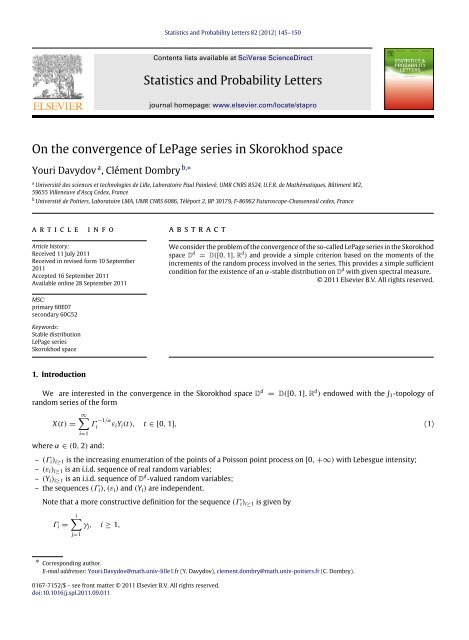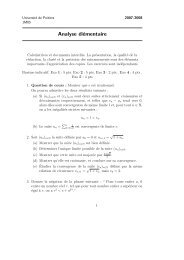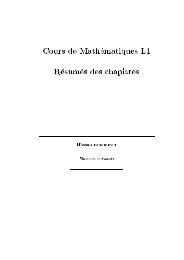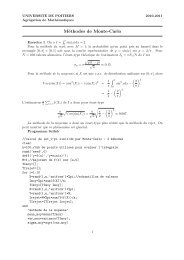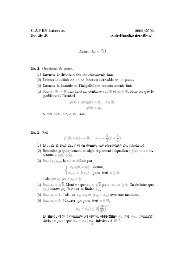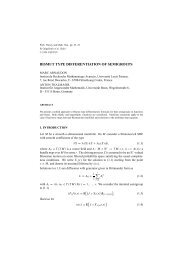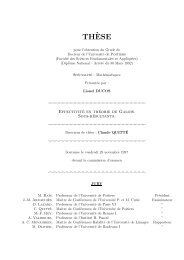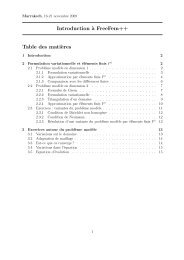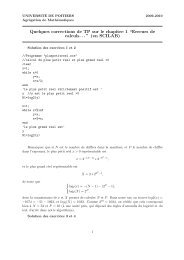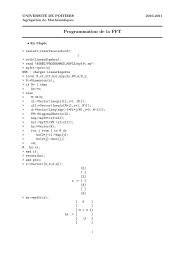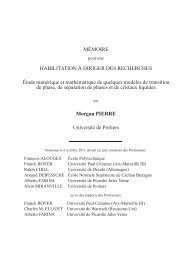On the convergence of LePage series in ... - Mathématiques
On the convergence of LePage series in ... - Mathématiques
On the convergence of LePage series in ... - Mathématiques
Create successful ePaper yourself
Turn your PDF publications into a flip-book with our unique Google optimized e-Paper software.
Statistics and Probability Letters 82 (2012) 145–150<br />
Contents lists available at SciVerse ScienceDirect<br />
Statistics and Probability Letters<br />
journal homepage: www.elsevier.com/locate/stapro<br />
<strong>On</strong> <strong>the</strong> <strong>convergence</strong> <strong>of</strong> <strong>LePage</strong> <strong>series</strong> <strong>in</strong> Skorokhod space<br />
Youri Davydov a , Clément Dombry b,∗<br />
a Université des sciences et technologies de Lille, Laboratoire Paul Pa<strong>in</strong>levé, UMR CNRS 8524, U.F.R. de Mathématiques, Bâtiment M2,<br />
59655 Villeneuve d’Ascq Cedex, France<br />
b Université de Poitiers, Laboratoire LMA, UMR CNRS 6086, Téléport 2, BP 30179, F-86962 Futuroscope-Chasseneuil cedex, France<br />
a r t i c l e<br />
i n f o<br />
a b s t r a c t<br />
Article history:<br />
Received 11 July 2011<br />
Received <strong>in</strong> revised form 10 September<br />
2011<br />
Accepted 16 September 2011<br />
Available onl<strong>in</strong>e 28 September 2011<br />
We consider <strong>the</strong> problem <strong>of</strong> <strong>the</strong> <strong>convergence</strong> <strong>of</strong> <strong>the</strong> so-called <strong>LePage</strong> <strong>series</strong> <strong>in</strong> <strong>the</strong> Skorokhod<br />
space D d = D([0, 1], R d ) and provide a simple criterion based on <strong>the</strong> moments <strong>of</strong> <strong>the</strong><br />
<strong>in</strong>crements <strong>of</strong> <strong>the</strong> random process <strong>in</strong>volved <strong>in</strong> <strong>the</strong> <strong>series</strong>. This provides a simple sufficient<br />
condition for <strong>the</strong> existence <strong>of</strong> an α-stable distribution on D d with given spectral measure.<br />
© 2011 Elsevier B.V. All rights reserved.<br />
MSC:<br />
primary 60E07<br />
secondary 60G52<br />
Keywords:<br />
Stable distribution<br />
<strong>LePage</strong> <strong>series</strong><br />
Skorokhod space<br />
1. Introduction<br />
We are <strong>in</strong>terested <strong>in</strong> <strong>the</strong> <strong>convergence</strong> <strong>in</strong> <strong>the</strong> Skorokhod space D d = D([0, 1], R d ) endowed with <strong>the</strong> J 1 -topology <strong>of</strong><br />
random <strong>series</strong> <strong>of</strong> <strong>the</strong> form<br />
∞−<br />
X(t) = Γ −1/α<br />
i<br />
ε i Y i (t), t ∈ [0, 1], (1)<br />
i=1<br />
where α ∈ (0, 2) and:<br />
– (Γ i ) i≥1 is <strong>the</strong> <strong>in</strong>creas<strong>in</strong>g enumeration <strong>of</strong> <strong>the</strong> po<strong>in</strong>ts <strong>of</strong> a Poisson po<strong>in</strong>t process on [0, +∞) with Lebesgue <strong>in</strong>tensity;<br />
– (ε i ) i≥1 is an i.i.d. sequence <strong>of</strong> real random variables;<br />
– (Y i ) i≥1 is an i.i.d. sequence <strong>of</strong> D d -valued random variables;<br />
– <strong>the</strong> sequences (Γ i ), (ε i ) and (Y i ) are <strong>in</strong>dependent.<br />
Note that a more constructive def<strong>in</strong>ition for <strong>the</strong> sequence (Γ i ) i≥1 is given by<br />
Γ i =<br />
i−<br />
γ j , i ≥ 1,<br />
j=1<br />
∗ Correspond<strong>in</strong>g author.<br />
E-mail addresses: Youri.Davydov@math.univ-lille1.fr (Y. Davydov), clement.dombry@math.univ-poitiers.fr (C. Dombry).<br />
0167-7152/$ – see front matter © 2011 Elsevier B.V. All rights reserved.<br />
doi:10.1016/j.spl.2011.09.011
146 Y. Davydov, C. Dombry / Statistics and Probability Letters 82 (2012) 145–150<br />
where (γ i ) i≥1 is an i.i.d. sequence <strong>of</strong> random variables with exponential distribution <strong>of</strong> parameter 1, and <strong>in</strong>dependent <strong>of</strong> (ε i )<br />
and (Y i ).<br />
Series <strong>of</strong> <strong>the</strong> form (1) are known as <strong>LePage</strong> <strong>series</strong>. For fixed t ∈ [0, 1], <strong>the</strong> <strong>convergence</strong> <strong>in</strong> R d <strong>of</strong> <strong>the</strong> <strong>series</strong> (1) is ensured<br />
as soon as one <strong>of</strong> <strong>the</strong> follow<strong>in</strong>g conditions is satisfied:<br />
– 0 < α < 1, E|ε 1 | α < ∞ and E|Y 1 (t)| α < ∞,<br />
– 1 ≤ α < 2, Eε 1 = 0, E|ε 1 | α < ∞ and E|Y 1 (t)| α < ∞.<br />
Here |.| denotes <strong>the</strong> usual Euclidean norm on R or on R d . The random variable X(t) has <strong>the</strong>n an α-stable distribution on<br />
R d . Conversely, it is well known that any α-stable distributions on R d admits a representation <strong>in</strong> terms <strong>of</strong> <strong>LePage</strong> <strong>series</strong> (see<br />
for example Samorodnitsky and Taqqu (1994), Section 3.9).<br />
There is a vast literature on symmetric α-stable distributions on separable Banach spaces (see e.g. Ledoux and Talagrand<br />
(1991), Araujo and G<strong>in</strong>é (1980)). In particular, any symmetric α-stable distribution on a separable Banach space can be<br />
represented as an almost surely convergent <strong>LePage</strong> <strong>series</strong> (see Corollary 5.5 <strong>in</strong> Ledoux and Talagrand (1991)). The existence<br />
<strong>of</strong> a symmetric α-stable distribution with a given spectral measure is not automatic and is l<strong>in</strong>ked with <strong>the</strong> notion <strong>of</strong> stable<br />
type <strong>of</strong> a Banach space; see Theorem 9.27 <strong>in</strong> Ledoux and Talagrand (1991) for a precise statement. Davydov et al. (2008)<br />
consider α-stable distributions <strong>in</strong> <strong>the</strong> more general framework <strong>of</strong> abstract convex cones.<br />
The space D d equipped with <strong>the</strong> norm<br />
‖x‖ = sup{|x i (t)|, t ∈ [0, 1], i = 1, . . . , d}, x = (x 1 , . . . , x d ) ∈ D d ,<br />
is a Banach space but is not separable. The uniform topology associated with this norm is f<strong>in</strong>er than <strong>the</strong> J 1 -topology. <strong>On</strong><br />
<strong>the</strong> o<strong>the</strong>r hand, <strong>the</strong> space D d with <strong>the</strong> J 1 -topology is Polish, i.e. <strong>the</strong>re exists a metric on D d compatible with <strong>the</strong> J 1 -topology<br />
that makes D d a complete and separable metric space. However, such a metric cannot be compatible with <strong>the</strong> vector space<br />
structure s<strong>in</strong>ce <strong>the</strong> addition is not cont<strong>in</strong>uous <strong>in</strong> <strong>the</strong> J 1 -topology. These properties expla<strong>in</strong> why <strong>the</strong> general <strong>the</strong>ory <strong>of</strong> stable<br />
distributions on separable Banach space cannot be applied to <strong>the</strong> space D d .<br />
Never<strong>the</strong>less, <strong>in</strong> <strong>the</strong> case where <strong>the</strong> <strong>series</strong> (1) converges, <strong>the</strong> distribution <strong>of</strong> <strong>the</strong> sum X def<strong>in</strong>es an α-stable distribution<br />
on D d . We can determ<strong>in</strong>e <strong>the</strong> associated spectral measure σ on <strong>the</strong> unit sphere S d = {x ∈ D d ; ‖x‖ = 1 }. It is given by<br />
<br />
<br />
E |ε 1 | α ‖Y 1 ‖ α 1 {sign(ε1 )Y 1 /‖Y 1 ‖∈A}<br />
σ (A) =<br />
,<br />
E(|ε 1 | α ‖Y 1 ‖ α A ∈ B(S d ).<br />
)<br />
This is closely related to regular variations <strong>the</strong>ory (see Hult and L<strong>in</strong>dskog (2006), Davis and Mikosch (2008)). For all r > 0<br />
and A ∈ B(S d ) such that σ (∂A) = 0, it holds that<br />
<br />
X<br />
lim nP n→∞ ‖X‖ ∈ A | ‖X‖ > rb n = r −α σ (A),<br />
with<br />
b n = <strong>in</strong>f{r > 0; P(‖X‖ < r) ≤ n −1 }, n ≥ 1.<br />
The random variable X is said to be regularly vary<strong>in</strong>g <strong>in</strong> D d with <strong>in</strong>dex α and spectral measure σ .<br />
In this framework, <strong>convergence</strong> <strong>of</strong> <strong>the</strong> <strong>LePage</strong> <strong>series</strong> (1) <strong>in</strong> D d is known <strong>in</strong> some particular cases only:<br />
– When 0 < α < 1, E|ε 1 | α < ∞ and E‖Y 1 ‖ α < ∞, <strong>the</strong> <strong>series</strong> (1) converges almost surely uniformly <strong>in</strong> [0, 1] (see example<br />
4.2 <strong>in</strong> Davis and Mikosch (2008)).<br />
– When 1 ≤ α < 2, <strong>the</strong> distribution <strong>of</strong> <strong>the</strong> ε i ’s is symmetric, E|ε 1 | α < ∞ and Y i (t) = 1 [0,t] (U) with (U i ) i≥1 an i.i.d.<br />
sequence <strong>of</strong> random variables with uniform distribution on [0, 1], <strong>the</strong> <strong>series</strong> (1) converges almost surely uniformly on<br />
[0, 1] and <strong>the</strong> limit process X is a symmetric α-stable Lévy process (see Rosiński (2001)).<br />
The purpose <strong>of</strong> this note is to complete <strong>the</strong>se results and to provide a general criterion for almost sure <strong>convergence</strong> <strong>in</strong> D d<br />
<strong>of</strong> <strong>the</strong> random <strong>series</strong> (1). Our ma<strong>in</strong> result is <strong>the</strong> follow<strong>in</strong>g:<br />
Theorem 1. Suppose that 1 ≤ α < 2,<br />
Eε 1 = 0, E|ε 1 | α < ∞ and E‖Y 1 ‖ α < ∞.<br />
Suppose fur<strong>the</strong>rmore that <strong>the</strong>re exist β 1 , β 2 > 1 and F 2 1, F 2 nondecreas<strong>in</strong>g cont<strong>in</strong>uous functions on [0, 1] such that, for all<br />
0 ≤ t 1 ≤ t ≤ t 2 ≤ 1,<br />
E|Y 1 (t 2 ) − Y 1 (t 1 )| 2 ≤ |F 1 (t 2 ) − F 1 (t 1 )| β 1<br />
, (2)<br />
E|Y 1 (t 2 ) − Y 1 (t)| 2 |Y 1 (t) − Y 1 (t 1 )| 2 ≤ |F 2 (t 2 ) − F 2 (t 1 )| 2β 2<br />
. (3)<br />
Then, <strong>the</strong> <strong>LePage</strong> <strong>series</strong> (1) converges almost surely <strong>in</strong> D d .<br />
The pro<strong>of</strong> <strong>of</strong> this <strong>the</strong>orem is detailed <strong>in</strong> <strong>the</strong> next section. We provide hereafter a few cases where Theorem 1 can be<br />
applied.
Y. Davydov, C. Dombry / Statistics and Probability Letters 82 (2012) 145–150 147<br />
Example 1. The example considered by Davis and Mikosch (2008) follows easily from Theorem 1: let U be a random variable<br />
with uniform distribution on [0, 1] and consider Y 1 (t) = 1 [0,t] (U), t ∈ [0, 1]. Then, for 0 ≤ t 1 ≤ t ≤ t 2 ≤ 1,<br />
E(Y 1 (t 2 ) − Y 1 (t 1 )) 2 = t 2 − t 1 and E(Y 1 (t 2 ) − Y 1 (t)) 2 (Y 1 (t) − Y 1 (t 1 )) 2 = 0,<br />
so conditions (2) and (3) are satisfied.<br />
Example 2. Example 1 can be generalized <strong>in</strong> <strong>the</strong> follow<strong>in</strong>g way: let p ≥ 1, (U i ) 1≤i≤p <strong>in</strong>dependent random variables on [0, 1]<br />
and (R i ) 1≤i≤p random variables on R d . Consider<br />
p−<br />
Y 1 (t) = R i 1 [0,t] (U i ).<br />
i=1<br />
Assume that for each i ∈ {1, . . . , p}, <strong>the</strong> cumulative distribution function F i <strong>of</strong> U i is cont<strong>in</strong>uous on [0, 1]. Assume fur<strong>the</strong>rmore<br />
that <strong>the</strong>re is some M > 0 such that for all i ∈ {1, . . . , p}<br />
E[R 4 i<br />
| F U ] ≤ M almost surely, (4)<br />
where F U = σ (U 1 , . . . , U p ). This is for example <strong>the</strong> case when <strong>the</strong> R i ’s are uniformly bounded by M 1/4 or when <strong>the</strong> R i ’s have<br />
f<strong>in</strong>ite fourth moment and are <strong>in</strong>dependent <strong>of</strong> <strong>the</strong> U i ’s. Simple computations entail that under condition (4), it holds for all<br />
0 ≤ t 1 ≤ t ≤ t 2 ≤ 1 that<br />
and<br />
E(Y 1 (t 2 ) − Y 1 (t 1 )) 2 ≤ M 1/2 p 2 |F(t 2 ) − F(t 1 )| 2<br />
E(Y 1 (t 2 ) − Y 1 (t)) 2 (Y 1 (t) − Y 1 (t 1 )) 2 ≤ Mp 4 |F(t 2 ) − F(t 1 )| 4 .<br />
with F(t) = ∑ p<br />
i=1 F i(t). So conditions (2) and (3) are satisfied and Theorem 1 can be applied <strong>in</strong> this case.<br />
Example 3. A fur<strong>the</strong>r natural example is <strong>the</strong> case where Y 1 (t) is a Poisson process with <strong>in</strong>tensity λ > 0 on [0, 1]. Then, for<br />
all 0 ≤ t 1 ≤ t ≤ t 2 ≤ 1,<br />
and<br />
E(Y 1 (t 2 ) − Y 1 (t 1 )) 2 = λ|t 2 − t 1 | + λ 2 |t 2 − t 1 | 2<br />
E(Y 1 (t 2 ) − Y 1 (t)) 2 (Y 1 (t) − Y 1 (t 1 )) 2 = (λ|t 2 − t| + λ 2 |t 2 − t| 2 )(λ|t − t 1 | + λ 2 |t − t 1 | 2 )<br />
and we easily see that conditions (2) and (3) are satisfied.<br />
2. Pro<strong>of</strong><br />
For <strong>the</strong> sake <strong>of</strong> clarity, we divide <strong>the</strong> pro<strong>of</strong> <strong>of</strong> Theorem 1 <strong>in</strong>to five steps.<br />
Step 1. Accord<strong>in</strong>g to Lemma 1.5.1 <strong>in</strong> Samorodnitsky and Taqqu (1994), it holds almost surely that for k large enough,<br />
<br />
|Γ −1/α<br />
k<br />
− k −1/α | ≤ 2α −1 k −1/α ln ln k<br />
. (5)<br />
k<br />
This implies <strong>the</strong> a.s. <strong>convergence</strong> <strong>of</strong> <strong>the</strong> <strong>series</strong><br />
∞−<br />
|Γ −1/α<br />
i<br />
− i −1/α | |ε i | ‖Y i ‖ < ∞. (6)<br />
i=1<br />
The <strong>series</strong> (6) does <strong>in</strong>deed have nonnegative terms, and (5) implies that <strong>the</strong> follow<strong>in</strong>g conditional expectation is f<strong>in</strong>ite:<br />
∞− <br />
E |Γ −1/α<br />
∞−<br />
i<br />
− i −1/α | |ε i | ‖Y i ‖<br />
F Γ = E|ε 1 | E‖Y i ‖ |Γ −1/α<br />
i<br />
− i −1/α |<br />
i=1<br />
i=1<br />
where F Γ = σ (Γ i , i ≥ 1).<br />
This proves that (6) holds true and it is enough to prove <strong>the</strong> a.s. <strong>convergence</strong> <strong>in</strong> D d <strong>of</strong> <strong>the</strong> <strong>series</strong><br />
∞−<br />
Z(t) = i −1/α ε i Y i (t), t ∈ [0, 1], (7)<br />
i=1<br />
Step 2. Next, consider<br />
∞−<br />
Z(t) = i −1/α ˜ε i Y i (t), t ∈ [0, 1]. (8)<br />
i=1
148 Y. Davydov, C. Dombry / Statistics and Probability Letters 82 (2012) 145–150<br />
with<br />
˜ε i = ε i 1 {|εi | α ≤i}, i ≥ 1.<br />
We prove that <strong>the</strong> <strong>series</strong> (7) and (8) differ only by a f<strong>in</strong>ite number <strong>of</strong> terms. We have <strong>in</strong>deed<br />
∞−<br />
∞−<br />
P (˜ε i ≠ ε i ) = P (|ε i | α > i) ≤ E|ε 1 | α < ∞<br />
i=1<br />
i=1<br />
and <strong>the</strong> Borel–Cantelli lemma implies that almost surely ˜ε i = ε i for i large enough. So, <strong>the</strong> two <strong>series</strong> (7) and (8) have <strong>the</strong><br />
same nature and it is enough to prove <strong>the</strong> <strong>convergence</strong> <strong>in</strong> D d <strong>of</strong> <strong>the</strong> <strong>series</strong> (8).<br />
Step 3. As a prelim<strong>in</strong>ary for step 4, we prove several estimates <strong>in</strong>volv<strong>in</strong>g <strong>the</strong> moments <strong>of</strong> <strong>the</strong> random variables (˜ε i ) i≥1 .<br />
First, for all m > α,<br />
C(α, m) :=<br />
∞−<br />
i −m/α E(|˜ε i | m ) < ∞. (9)<br />
i=1<br />
We have <strong>in</strong>deed<br />
C(α, m) =<br />
∞−<br />
i −m/α E(|ε i | m 1 {|εi |≤i 1/α })<br />
i=1<br />
<br />
<br />
∞−<br />
= E |ε 1 | m i −m/α 1 {i≥|ε1 | α }<br />
i=1<br />
≤ CE(|ε 1 | m |ε 1 | α−m ) = CE(|ε 1 | α ) < ∞<br />
where <strong>the</strong> constant C = sup x>0 x m/α−1 ∑ i≥x i−m/α is f<strong>in</strong>ite s<strong>in</strong>ce for m > α<br />
lim<br />
x→∞ xm/α−1<br />
∞−<br />
i −m/α =<br />
i≥x<br />
Similarly, we also have<br />
α<br />
m − α .<br />
C(α, 1) :=<br />
∞−<br />
i −1/α |E(˜ε i )| < ∞. (10)<br />
i=1<br />
Indeed, <strong>the</strong> assumption Eε i = 0 implies E(˜ε i ) = E(ε i 1 {|εi | α >i}). Hence,<br />
∞−<br />
i −1/α |E(˜ε i )| ≤<br />
i=1<br />
∞−<br />
i −1/α E(|ε 1 |1 {|ε1 |>i 1/α })<br />
i=1<br />
<br />
= E |ε 1 |<br />
[|ε − 1 | α ]<br />
i=1<br />
i −1/α<br />
<br />
≤ E |ε 1 |C ′ (|ε 1 | α ) 1−1/α = C ′ E|ε 1 | α < ∞<br />
where <strong>the</strong> constant C ′ = sup x>0 x 1/α−1 ∑ [x]<br />
i=1 i−1/α is f<strong>in</strong>ite.<br />
Step 4. For n ≥ 1, consider <strong>the</strong> partial sum<br />
Zn (t) =<br />
n−<br />
i −1/α ˜ε i Y i (t), t ∈ [0, 1]. (11)<br />
i=1<br />
We prove that <strong>the</strong> sequence <strong>of</strong> processes ( Zn ) n≥1 is tight <strong>in</strong> D d . Follow<strong>in</strong>g Theorem 3 <strong>in</strong> Gikhman and Skorokhod (2004),<br />
Chapter 6, Section 3, it is enough to show that <strong>the</strong>re exists β > 1/2 and a nondecreas<strong>in</strong>g cont<strong>in</strong>uous function F on [0, 1]<br />
such that<br />
E| Zn (t 2 ) − Zn (t)| 2 | Zn (t) − Zn (t 1 )| 2 ≤ |F(t 2 ) − F(t 1 )| 2β , (12)<br />
for all 0 ≤ t 1 ≤ t ≤ t 2 ≤ 1. Remark that <strong>in</strong> Gikhman and Skorokhod (2004), <strong>the</strong> result is stated only for F(t) ≡ t. However,<br />
<strong>the</strong> case <strong>of</strong> a general cont<strong>in</strong>uous nondecreas<strong>in</strong>g function F follows easily from a simple change <strong>of</strong> variable.
Y. Davydov, C. Dombry / Statistics and Probability Letters 82 (2012) 145–150 149<br />
We use <strong>the</strong> notation Y(t) = (Y p (t)) 1≤p≤d , [[1, n]] = {1, . . . , n} and i = (i 1 , i 2 , i 3 , i 4 ) ∈ [[1, n]] 4 . We have<br />
E| Zn (t 2 ) − Zn (t)| 2 | Zn (t) − Zn (t 1 )| 2 n−<br />
2 2<br />
= E<br />
i −1/α <br />
n−<br />
˜ε<br />
<br />
i (Y i (t) − Y i (t 1 ))<br />
j −1/α ˜ε<br />
<br />
j (Y j (t 2 ) − Y j (t))<br />
<br />
i=1<br />
j=1<br />
= − −<br />
(i 1 i 2 i 3 i 4 ) −1/α E(˜ε i1 ˜ε i2 ˜ε i3 ˜ε i4 )E[(Y p<br />
i 1<br />
(t) − Y p<br />
i 1<br />
(t 1 )) (13)<br />
1≤p,q≤d i∈[[1,n]] 4<br />
where<br />
(Y p<br />
i 2<br />
(t) − Y p<br />
i 2<br />
(t 1 ))(Y q<br />
i 3<br />
(t 2 ) − Y q<br />
i 3<br />
(t))(Y q<br />
i 4<br />
(t 2 ) − Y q<br />
i 4<br />
(t))] (14)<br />
−<br />
≤ d 2 (i 1 i 2 i 3 i 4 ) −1/α |E(˜ε i1 ˜ε i2 ˜ε i3 ˜ε i4 )|D i (t, t 1 , t 2 ) (15)<br />
i∈[[1,n]] 4<br />
D i (t, t 1 , t 2 ) = E|Y i1 (t) − Y i1 (t 1 )‖Y i2 (t) − Y i2 (t 1 )‖Y i3 (t 2 ) − Y i3 (t) ‖ Y i4 (t 2 ) − Y i4 (t)|.<br />
Consider ∼ i , <strong>the</strong> equivalence relation on {1, . . . , 4} def<strong>in</strong>ed by<br />
j ∼ i j ′ if and only if i j = i j ′.<br />
Let P be <strong>the</strong> set <strong>of</strong> all partitions <strong>of</strong> {1, . . . , 4} and τ(i) be <strong>the</strong> partition <strong>of</strong> {1, 2, 3, 4} given by <strong>the</strong> equivalence classes <strong>of</strong> ∼ i .<br />
We <strong>in</strong>troduce <strong>the</strong>se def<strong>in</strong>itions because, s<strong>in</strong>ce <strong>the</strong> Y i ’s are i.i.d., <strong>the</strong> term D i (t, t 1 , t 2 ) depends on i only through <strong>the</strong> associated<br />
partition τ(i). For example, if τ(i) = {1, 2, 3, 4}, i.e. if i 1 = i 2 = i 3 = i 4 , <strong>the</strong>n<br />
D i (t, t 1 , t 2 ) = E|Y 1 (t) − Y 1 (t 1 )| 2 |Y 1 (t 2 ) − Y 1 (t)| 2 .<br />
Or if τ(i) = {1} ∪ {2} ∪ {3} ∪ {4}, i.e. if <strong>the</strong> <strong>in</strong>dices i 1 , . . . , i 4 are pairwise dist<strong>in</strong>ct, <strong>the</strong>n<br />
D i (t, t 1 , t 2 ) = (E|Y 1 (t) − Y 1 (t 1 )|E|Y 1 (t 2 ) − Y 1 (t)|) 2 .<br />
For τ ∈ P , we denote by D τ (t, t 1 , t 2 ) <strong>the</strong> common value <strong>of</strong> <strong>the</strong> terms D i (t, t 1 , t 2 ) correspond<strong>in</strong>g to <strong>in</strong>dices i such that<br />
τ(i) = τ . Def<strong>in</strong>e also<br />
−<br />
S n,τ =<br />
(i 1 i 2 i 3 i 4 ) −1/α |E(˜ε i1 ˜ε i2 ˜ε i3 ˜ε i4 )|.<br />
i∈{1,...,n} 4 ;τ(i)=τ<br />
With this notation, Eq. (15) can be rewritten as<br />
E| Zn (t 2 ) − Zn (t)| 2 | Zn (t) − Zn (t 1 )| 2 ≤ d 2 − τ∈P<br />
S n,τ D τ (t, t 1 , t 2 ). (16)<br />
Under conditions (2) and (3), we will prove that for each τ ∈ P , <strong>the</strong>re exist β τ > 1/2, a nondecreas<strong>in</strong>g cont<strong>in</strong>uous function<br />
F τ on [0, 1] and a constant S τ > 0 such that<br />
and<br />
D τ (t, t 1 , t 2 ) ≤ |F τ (t 1 ) − F τ (t 2 )| 2β τ<br />
, 0 ≤ t 1 ≤ t ≤ t 2 , (17)<br />
S n,τ ≤ S τ , n ≥ 1. (18)<br />
Eqs. (16)–(18) toge<strong>the</strong>r imply <strong>in</strong>equality (12) for some suitable choices <strong>of</strong> β > 1/2 and F.<br />
It rema<strong>in</strong>s to prove <strong>in</strong>equalities (17) and (18). If τ = {1, 2, 3, 4},<br />
and<br />
D τ (t, t 1 , t 2 ) ≤ E|Y 1 (t) − Y 1 (t 1 )| 2 |Y 1 (t 2 ) − Y 1 (t)| 2 ≤ |F 2 (t 2 ) − F 2 (t 1 )| 2β 2<br />
S τ n =<br />
n−<br />
i −4/α E˜ε 4 i<br />
≤ C(α, 4).<br />
i=1<br />
If τ = {1} ∪ {2} ∪ {3} ∪ {4}, <strong>the</strong> Cauchy–Schwartz <strong>in</strong>equality entails<br />
D τ (t, t 1 , t 2 ) ≤ (E|Y 1 (t) − Y 1 (t 1 )|E|Y 1 (t 2 ) − Y 1 (t)|) 2 ≤ |F 1 (t 2 ) − F 1 (t 1 )| 2β 1<br />
and<br />
S τ ≤<br />
−<br />
n<br />
(i 1 i 2 i 3 i 4 ) −1/α |E˜ε i1 ‖E˜ε i2 ‖E˜ε i3 ‖ E˜ε i4 | ≤ C(α, 1) 4 .<br />
i∈{1,...,n} 4 ;τ(i)=τ
150 Y. Davydov, C. Dombry / Statistics and Probability Letters 82 (2012) 145–150<br />
Similarly, for τ = {1, 2, 3} ∪ {4},<br />
D τ (t, t 1 , t 2 ) = E|Y 1 (t) − Y 1 (t 1 )| 2 |Y 1 (t 2 ) − Y 1 (t)|E|Y 1 (t 2 ) − Y 1 (t)|<br />
≤ |F 1 (t) − F 1 (t 1 )| β 1/2 |F 2 (t 2 ) − F 2 (t 1 )| β 2<br />
|F 1 (t 2 ) − F 1 (t)| β 1/2<br />
≤ |(F 1 + F 2 )(t 2 ) − (F 1 + F 2 )(t 1 )| β 1+β 2<br />
and<br />
S τ ≤<br />
−<br />
n<br />
(i 3 j) −1/α E|˜ε i | 3 |E˜ε j | ≤ C(α, 3)C(α, 3).<br />
1≤i≠j≤n<br />
or for τ = {1, 2} ∪ {3} ∪ {4},<br />
D τ (t, t 1 , t 2 ) = E|Y 1 (t) − Y 1 (t 1 )| 2 (E|Y 1 (t 2 ) − Y 1 (t)|) 2<br />
≤ |F 1 (t) − F 1 (t 1 )| β 1<br />
|F 1 (t 2 ) − F 1 (t)| β 1<br />
≤ |F 1 (t 2 ) − F 1 (t 1 )| 2β 1<br />
and<br />
S τ ≤<br />
−<br />
n<br />
(i 2 jk) −1/α E|˜ε i | 2 |E˜ε j ‖ E˜ε k | ≤ C(α, 2)C(α, 1) 2 .<br />
1≤i≠j≠k≤n<br />
Similar computations can be checked <strong>in</strong> all rema<strong>in</strong><strong>in</strong>g cases. The card<strong>in</strong>ality <strong>of</strong> P is equal to 13.<br />
Step 5. We prove Theorem 1. For each fixed t ∈ [0, 1], Kolmogorov’s three-<strong>series</strong> <strong>the</strong>orem implies that Zn (t) converges<br />
almost surely as n → ∞. So <strong>the</strong> f<strong>in</strong>ite-dimensional distributions <strong>of</strong> ( Zn ) n≥1 converge. The tightness <strong>in</strong> D d <strong>of</strong> <strong>the</strong> sequence<br />
has already been proved <strong>in</strong> step 4, so ( Zn ) n≥1 weakly converges <strong>in</strong> D d as n → ∞. We <strong>the</strong>n apply Theorem 1 <strong>of</strong> Kallenberg<br />
(1974) and deduce that Zn converges almost surely <strong>in</strong> D d . In view <strong>of</strong> step 1 and step 2, this yields <strong>the</strong> almost sure <strong>convergence</strong><br />
<strong>of</strong> <strong>the</strong> <strong>series</strong> (1). □<br />
References<br />
Araujo, A., G<strong>in</strong>é, E., 1980. The central limit <strong>the</strong>orem for real and Banach valued random variables. In: Wiley Series <strong>in</strong> Probability and Ma<strong>the</strong>matical Statistics.<br />
John Wiley & Sons, New York, Chichester, Brisbane.<br />
Davis, R.A., Mikosch, T., 2008. Extreme value <strong>the</strong>ory for space–time processes with heavy-tailed distributions. Stochastic Process. Appl. 118, 560–584.<br />
Davydov, Y., Molchanov, I., Zuyev, S., 2008. Strictly stable distributions on convex cones. Electron. J. Probab. 13 (11), 259–321.<br />
Gikhman, I.I., Skorokhod, A.V., 2004, The <strong>the</strong>ory <strong>of</strong> stochastic processes. I, Classics <strong>in</strong> Ma<strong>the</strong>matics, Spr<strong>in</strong>ger-Verlag, Berl<strong>in</strong>, Translated from <strong>the</strong> Russian by<br />
S. Kotz, Repr<strong>in</strong>t <strong>of</strong> <strong>the</strong> 1974 edition.<br />
Hult, H., L<strong>in</strong>dskog, F., 2006. Regular variation for measures on metric spaces. Publ. Inst. Math. Beograd N S 80 (94), 121–140.<br />
Kallenberg, O., 1974. Series <strong>of</strong> random processes without discont<strong>in</strong>uities <strong>of</strong> <strong>the</strong> second k<strong>in</strong>d. Ann. Probability 2, 729–737.<br />
Ledoux, M., Talagrand, M., 1991. Isoperimetry and processes. In: Probability <strong>in</strong> Banach spaces. In: Ergebnisse der Ma<strong>the</strong>matik und ihrer Grenzgebiete (3)<br />
(Results <strong>in</strong> Ma<strong>the</strong>matics and Related Areas (3)), vol. 23. Spr<strong>in</strong>ger-Verlag, Berl<strong>in</strong>.<br />
Rosiński, J., 2001. Series representations <strong>of</strong> Lévy processes from <strong>the</strong> perspective <strong>of</strong> po<strong>in</strong>t processes. In: Lévy Processes. Birkhäuser Boston, Boston, MA,<br />
pp. 401–415.<br />
Samorodnitsky, G., Taqqu, M.S., 1994. Stable non-Gaussian random processes. In: Stochastic Model<strong>in</strong>g. Chapman & Hall, New York, Stochastic models with<br />
<strong>in</strong>f<strong>in</strong>ite variance.


